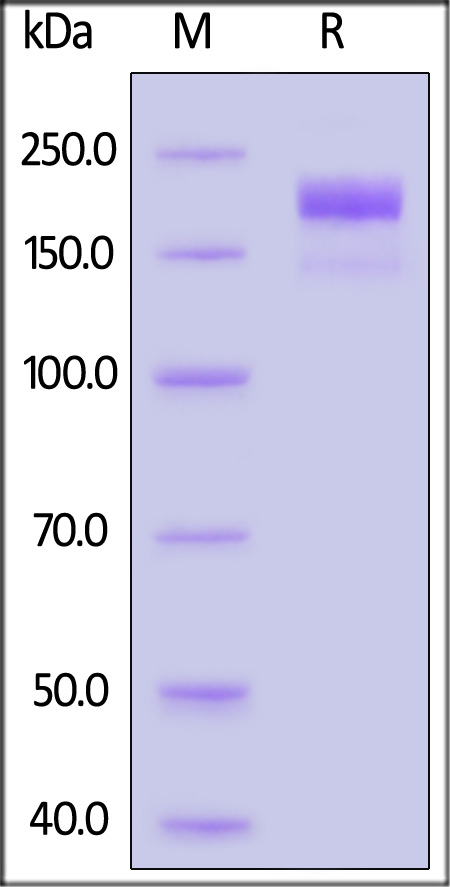分子别名(Synonym)
Spike,S protein,Spike glycoprotein,S glycoprotein
表达区间及表达系统(Source)
SARS-CoV-2 Spike Trimer, His Tag (BA.2.74/Omicron) (SPN-C522h) is expressed from human 293 cells (HEK293). It contains AA Val 16 - Pro 1213 (Accession # QHD43416.1 (T19I, LPP24-26del, A27S, G142D, V213G, G339D, R346T, S371F, S373P, S375F, T376A, D405N, R408S, K417N, N440K, L452M, S477N, T478K, E484A, Q493R, Q498R, N501Y, Y505H, D614G, H655Y, N679K, P681H, N764K, D796Y, Q954H, N969K, R683A, R685A, F817P, A892P, A899P, A942P, K986P, V987P)). The spike mutations are identified on the SARS-CoV-2 Omicron variant (Pango lineage: BA.2.74). The recombinant protein is expressed from human 293 cells (HEK293) with T4 fibritin trimerization motif and a polyhistidine tag at the C-terminus. Proline substitutions (F817P, A892P, A899P, A942P, K986P, V987P) and alanine substitutions (R683A and R685A) are introduced to stabilize the trimeric prefusion state of SARS-CoV-2 S protein and abolish the furin cleavage site, respectively.
Predicted N-terminus: Val 16
Request for sequence
蛋白结构(Molecular Characterization)
This protein carries a polyhistidine tag at the C-terminus.
The protein has a calculated MW of 138.0 kDa. The protein migrates as 170-200 kDa under reducing (R) condition (SDS-PAGE) due to glycosylation.
内毒素(Endotoxin)
Less than 1.0 EU per μg by the LAL method.
纯度(Purity)
>90% as determined by SDS-PAGE.
>90% as determined by SEC-MALS.
制剂(Formulation)
Lyophilized from 0.22 μm filtered solution in 0.1 M Sodium citrate, pH5.5 with trehalose as protectant.
Contact us for customized product form or formulation.
重构方法(Reconstitution)
Please see Certificate of Analysis for specific instructions.
For best performance, we strongly recommend you to follow the reconstitution protocol provided in the CoA.
存储(Storage)
For long term storage, the product should be stored at lyophilized state at -20°C or lower.
Please avoid repeated freeze-thaw cycles.
This product is stable after storage at:
- -20°C to -70°C for 12 months in lyophilized state;
- -70°C for 3 months under sterile conditions after reconstitution.
质量管理控制体系(QMS)
电泳(SDS-PAGE)

SARS-CoV-2 Spike Trimer, His Tag (BA.2.74/Omicron) on SDS-PAGE under reducing (R) condition. The gel was stained with Coomassie Blue. The purity of the protein is greater than 90%.
SEC-MALS

The purity of SARS-CoV-2 Spike Trimer, His Tag (BA.2.74/Omicron) (Cat. No. SPN-C522h) is more than 90% and the molecular weight of this protein is around 546-604 kDa verified by SEC-MALS.
Report
活性(Bioactivity)-ELISA

Immobilized SARS-CoV-2 Spike Trimer, His Tag (BA.2.74/Omicron) (Cat. No. SPN-C522h) at 1 μg/mL (100 μL/well) can bind Human ACE2, Fc Tag (Cat. No. AC2-H5257) with a linear range of 0.1-16 ng/mL (QC tested).
Protocol

Immobilized SARS-CoV-2 Spike Trimer, His Tag (BA.2.74/Omicron) (Cat. No. SPN-C522h) at 1 μg/mL (100 μL/well) can bind Anti-SARS-CoV-2 Spike RBD Antibody, Chimeric mAb, Human IgG1 (Cat. No. S1N-M122) with a linear range of 0.1-8 ng/mL (Routinely tested).
Protocol

Immobilized SARS-CoV-2 Spike Trimer, His Tag (BA.2.74/Omicron) (Cat. No. SPN-C522h) at 1 μg/mL (100 μL/well) can bind Anti-SARS-CoV-2 Spike RBD Broadly Neutralizing Antibody, Human IgG1 (Cat. No. SPD-M265) with a linear range of 0.1-4 ng/mL (Routinely tested).
Protocol

Immobilized SARS-CoV-2 Spike Trimer, His Tag (BA.2.74/Omicron) (Cat. No. SPN-C522h) at 1 μg/mL (100 μL/well) can bind Anti-SARS-CoV-2 Spike RBD Antibody, Mouse IgG1 (Omicron Specific) (Cat. No. SPD-M305) with a linear range of 0.5-16 ng/mL (Routinely tested).
Protocol
背景(Background)
It's been reported that SARS-CoV-2 can infect the human respiratory epithelial cells through interaction with the human ACE2 receptor. The spike protein is a large type I transmembrane protein containing two subunits, S1 and S2. S1 mainly contains a receptor binding domain (RBD), which is responsible for recognizing the cell surface receptor. S2 contains basic elements needed for the membrane fusion.The S protein plays key parts in the induction of neutralizing-antibody and T-cell responses, as well as protective immunity.























































 膜杰作
膜杰作 Star Staining
Star Staining















